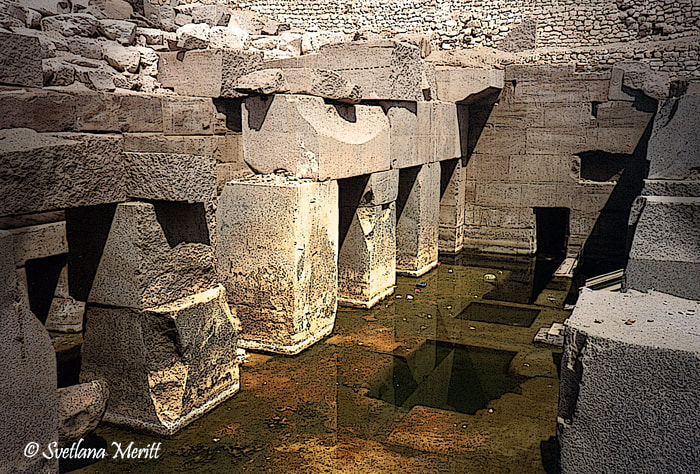|
The Osireion is an anomaly in the archaeology of ancient Egypt. (“Anomaly” is the scientific euphemism for “mystery.”) Mainstream archaeologists usually deal with such anomalies by either ignoring them (because they don’t know how to explain them), or using inconclusive evidence to fit them into the accepted time framework.
The Osireion is a small temple at Abydos (middle of Egypt), located behind the main temple of Seti I. Conventional archaeology dates it to 1300BC, but stylistic differences and erosion patterns, as well as the fact that it was built below the present-day ground level, indicate a much earlier construction date. The Osireion is one of the only two examples in Egypt of monolithic granite architecture (the other is the Valley Temple next to the Sphinx—another “anomaly”). The red granite blocks you see in the picture weigh up to 100 tons. In its bare grandeur, the Osireion echoes other Cyclopean structures around the world, in particular lake Tiwanaku in Bolivia, but also Mycenae in Greece (see my post "The Lion Gate"), and even some megalithic temples of Malta. According to the French esotericist, alchemist, and Egyptologist Schwaller de Lubitz, Egyptian civilization appeared complete at its beginning. There is no sign of a period of development; if anything, it only deteriorated from its outset. Ancient Egyptian documents refer to the period when Egypt was ruled by Shemsu Hor (the Followers of Horus), a group of highly evolved beings that transmitted a complete package of knowledge—writing, arts, astronomy, architecture—to a primitive, Neolithic culture of the pre-Dynastic Egypt. The Osireion is one of those places on earth where you stand in awe of mystery.
0 Comments
Leave a Reply. |
Overview
All
|

